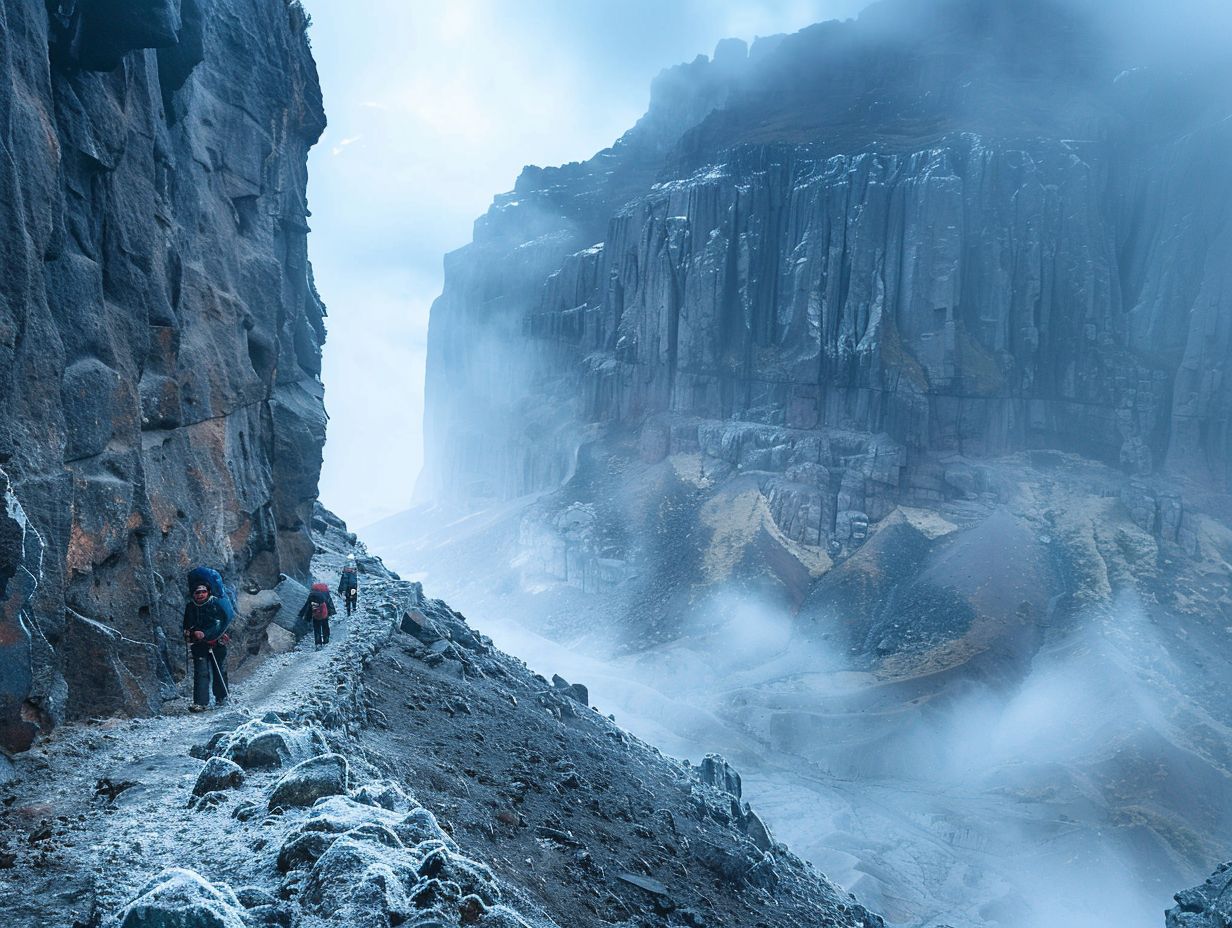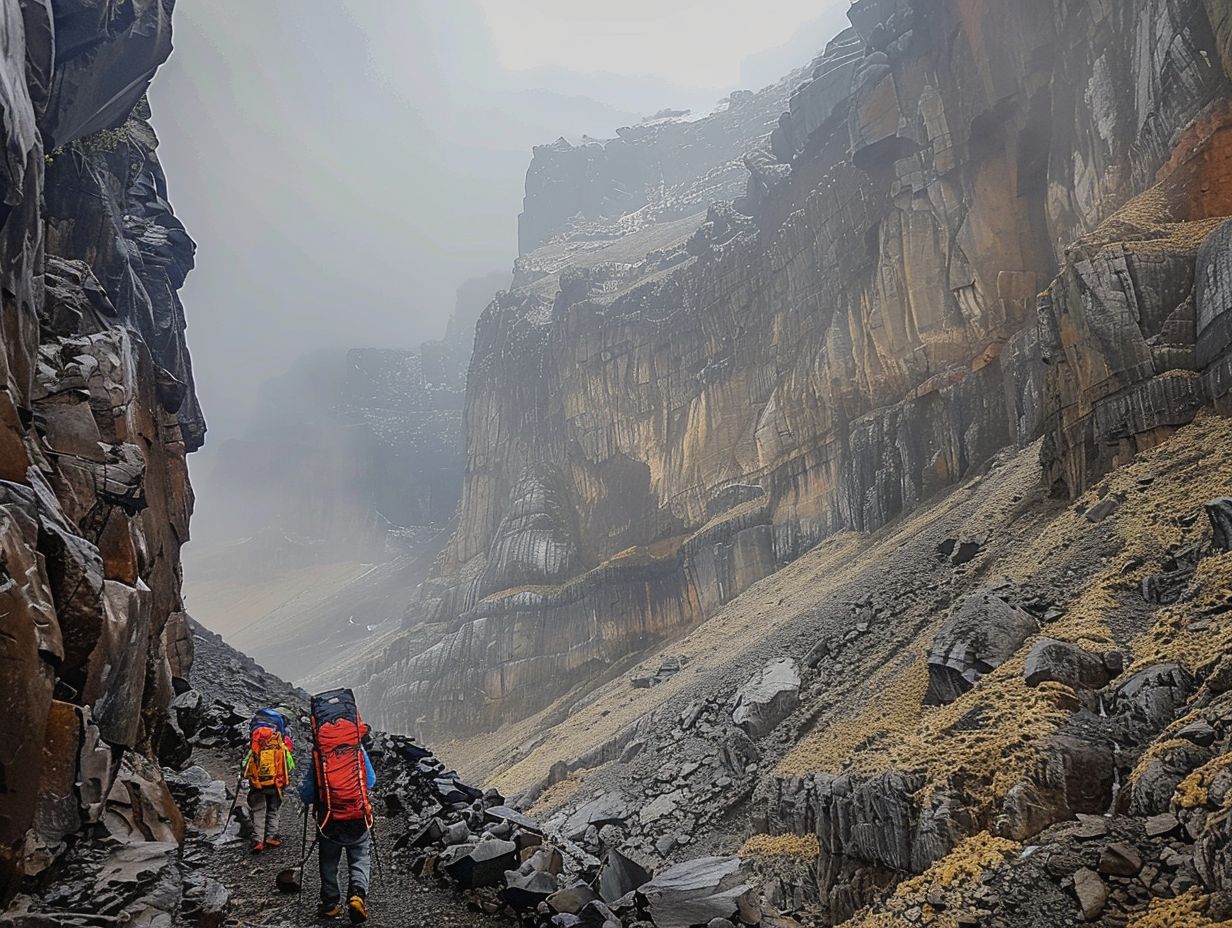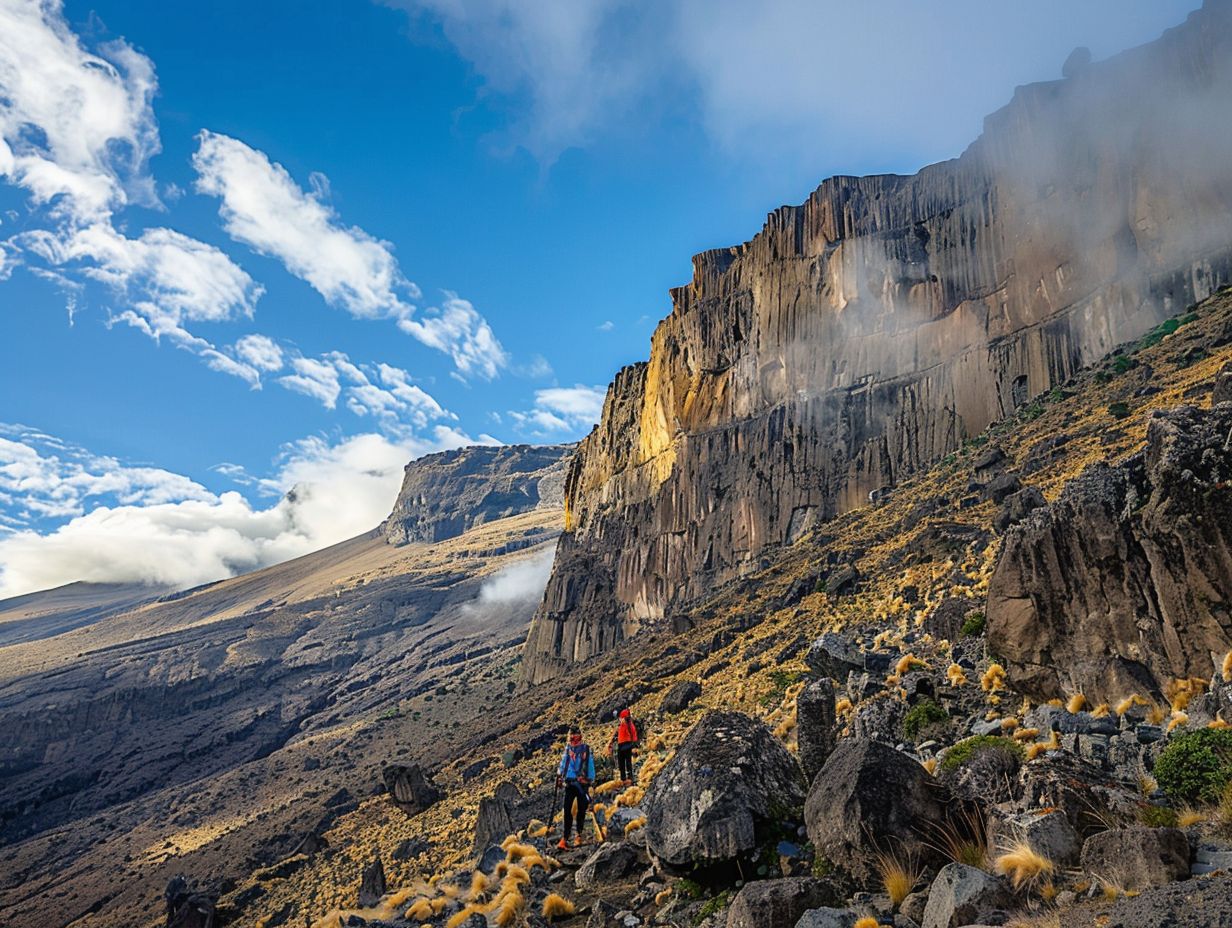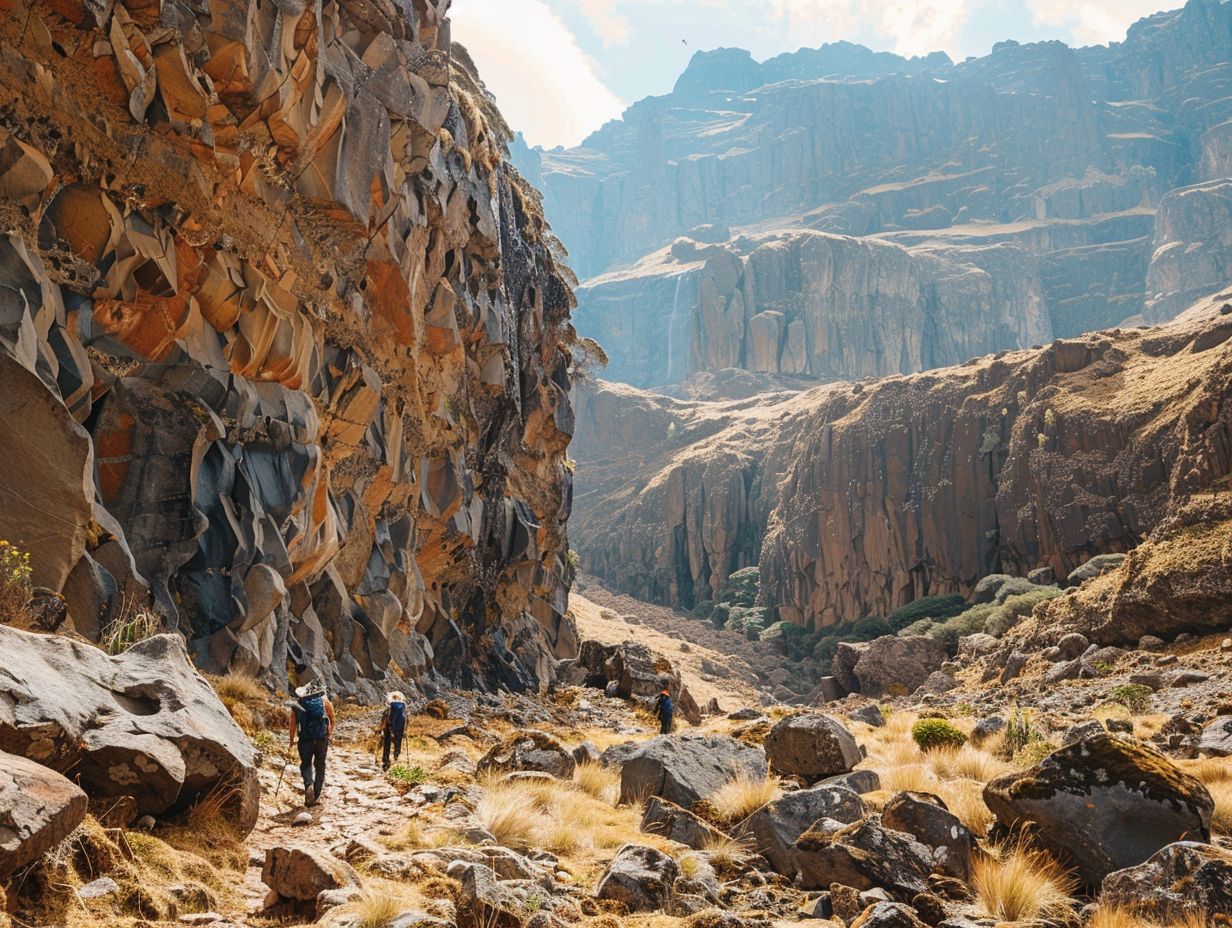
Barranco Wall Mount Kilimanjaro
Have you ever wondered what it’s like to climb the famous Barranco Wall on Mount Kilimanjaro?
This challenging section of the mountain offers breathtaking views and a test of your climbing skills.
We will explore the location of the Barranco Wall, its difficulty level, the challenges you may face, the best time to climb, the stunning scenery you’ll encounter, safety precautions to take, equipment needed, accommodation options nearby, costs involved, and reviews from previous climbers.
Get ready to prepare yourself for an unforgettable adventure on the Barranco Wall!
Key Takeaways:

- The Barranco Wall on Mount Kilimanjaro is a challenging yet rewarding trek that offers stunning views of the surrounding landscape.
- The best time to climb the Barranco Wall is during the dry season, from June to October, when the weather is most favorable.
- Safety precautions, proper equipment, and experienced guides are essential for a successful climb of the Barranco Wall on Mount Kilimanjaro.
What is the Barranco Wall on Mount Kilimanjaro?
The Barranco Wall on Mount Kilimanjaro is a towering rock face that forms part of the climb to the summit, offering a challenging yet rewarding ascent for climbers.
Standing approximately 257 meters tall, the Barranco Wall is a stunning natural feature that showcases the raw beauty of Kilimanjaro. Its rugged surface, characterized by large boulders and narrow passages, requires climbers to navigate strategically, often using their hands and feet to scale the steep incline. Many consider this section of the climb to be one of the most exhilarating and physically demanding parts of the journey.
Where is the Barranco Wall located on Mount Kilimanjaro?
The Barranco Wall is situated along the Lemosho route on Mount Kilimanjaro, providing a strategic point in the climb towards the summit.
As climbers navigate their way through the Lemosho route, Brancco Wall stands as a challenging yet exhilarating section that adds a thrill to their ascent. The wall is positioned between the Kibo and Shira peaks, offering a breathtaking view of the surrounding landscape and serving as a natural barrier that demands technical skills and determination from the climbers.
The Barranco Wall plays a pivotal role in the overall climbing route by testing the climbers’ agility and endurance, preparing them for the more demanding sections ahead. As they conquer this steep incline, they are rewarded with a sense of accomplishment and closer proximity to the ultimate goal of reaching Uhuru Peak.
What is the Difficulty Level of the Barranco Wall?
The Barranco Wall presents a moderate to challenging difficulty level for climbers, requiring a combination of climbing skills, technical experience, and physical endurance to navigate its steep sections.
As climbers ascend the Barranco Wall, they encounter a mix of rock faces, loose scree, and narrow passages that demand precision and focus.
Expertise in route-finding becomes crucial, as the wall features various routes of different complexities. Climbers must possess a good understanding of belaying techniques, anchor construction, and rope management to safely overcome the obstacles.
Physical fitness is essential, as the ascent involves both technical climbing maneuvers and strenuous physical exertion. To conquer the Barranco Wall, climbers often employ roped climbing techniques, relying on teamwork and communication to navigate the challenging terrain.
-
What Are the Challenges of Climbing the Barranco Wall?
Climbing the Barranco Wall poses challenges such as steep inclines, altitude-related issues due to the high elevation, and potential climbing dangers like loose rocks and difficult terrain that require proper acclimatization and caution.
At high altitudes, climbers may experience symptoms of altitude sickness, such as headache, nausea, and fatigue, which can significantly impact their performance and safety. The air becomes thinner, making it harder to breathe and putting extra strain on the body.
Tackling the Barranco Wall with these conditions requires not just physical strength, but mental determination as well. The unpredictable nature of mountain weather adds another layer of complexity to the climb, with sudden changes in conditions posing a real threat to climbers’ well-being. Therefore, adequate preparation, acclimatization, and adherence to safety protocols are paramount for a successful ascent of this challenging terrain.
What is the Best Time to Climb the Barranco Wall?

The best time to climb the Barranco Wall is during the dry seasons on Mount Kilimanjaro when the weather is stable, minimizing the risks associated with precipitation and ensuring safer climbing conditions.
During the dry seasons, which typically fall between June to October and December to February, climbers have a higher chance of clear skies and good visibility, which are crucial for a successful summit attempt on Mount Kilimanjaro.
Choosing the right time to ascend the Barranco Wall is essential for acclimatization, allowing climbers to adjust to the altitude gradually and reduce the risk of altitude sickness during the strenuous climb. It is advisable to check for any recent volcanic activity in the region and monitor health requirements, like vaccination recommendations, to ensure a safe and enjoyable trek.
What is the Scenery Like on the Barranco Wall?
The Barranco Wall offers breathtaking scenery with panoramic views of the surrounding landscapes, including iconic landmarks like the Kissing Rock, providing climbers with a picturesque backdrop during their ascent.
As climbers make their way up the Barranco Wall, they are greeted with stunning rock formations and lush greenery that add to the surreal beauty of this natural wonder. The Kissing Rock, a distinctive geological formation that appears to lean in and touch another rock, serves as a notable point of interest along the route.
Surrounded by a diverse array of flora and fauna, the Barranco Wall creates a sense of immersion in nature, with the cool breeze and occasional chirping of birds enhancing the overall climbing experience.
What Are the Safety Precautions When Climbing the Barranco Wall?
Safety precautions when climbing the Barranco Wall include staying alert for potential climbing dangers like landslides, ensuring proper gear usage, following experienced guides’ instructions, and practicing caution in challenging terrain.
One of the key aspects of climbing the Barranco Wall is selecting the right equipment, including sturdy climbing shoes, a reliable harness, and a helmet to protect against potential rockfall.
It’s crucial to check all gear for any signs of wear and tear before embarking on the ascent to minimize risks. Experienced guides play a vital role in providing valuable insights on the best routes, weather conditions, and equipment handling. Their expertise can make a significant difference in ensuring a safe and successful climb.
What Equipment Do You Need to Climb the Barranco Wall?
To climb the Barranco Wall, essential equipment includes climbing gear such as harnesses, helmets, sturdy boots, trekking poles for stability, and appropriate clothing for varying weather conditions.
One crucial piece of gear for ascending the Barranco Wall is a quality climbing harness, which securely attaches you to the rope system and provides support during the climb. A well-fitted helmet is another non-negotiable, offering protection from falling rocks or debris. Sturdy boots with excellent grip are vital for navigating the rocky terrain, ensuring stability and preventing slips.
Trekking poles are critical for maintaining balance on steep sections and reducing strain on your legs. In terms of clothing, layering is key for adapting to changing weather conditions, from sunny spells to sudden showers or chilly winds.
Are There Any Guides Available for Climbing the Barranco Wall?
Experienced guides are available to assist climbers in navigating the Barranco Wall, providing valuable support, safety expertise, and insights into the terrain, albeit with associated climbing costs.
Climbers embarking on the daunting Barranco Wall can benefit greatly from the presence of these seasoned guides who possess a deep understanding of the mountain’s twists and turns. With their guidance, climbers can navigate the challenges of the wall more effectively, ensuring a safer and more enjoyable ascent. These guides not only enhance the overall experience but also contribute significantly to the climbers’ safety, especially in tricky sections. It’s important to note that while their services come at a cost, the knowledge and experience they bring are priceless in the context of successful and secure climbing adventures.
What Are the Alternatives to Climbing the Barranco Wall?

For those seeking alternatives to climbing the Barranco Wall, exploring different routes such as the Lemosho route, Machame route, Umbwe route, Shira route, Northern Circuit route, or Rongai route can provide diverse experiences and paths to the summit of Mount Kilimanjaro.
Each route offers its unique attractions and challenges.
- The Lemosho route, known for its scenic beauty and gradual ascent, allows climbers to acclimatize well.
- The Machame route, often called the ‘Whiskey Route,’ is popular for its varied terrain, including lush rainforest and alpine desert landscapes.
- If seeking a more direct and challenging climb, the Umbwe route with its steep slopes can be an exciting option.
- The Shira route offers stunning views of the Shira Plateau.
- The Northern Circuit route provides a longer, less crowded journey around the mountain.
- The Rongai route is known for its scenic wilderness and a quieter, more peaceful climb.
What Other Routes Can You Take to Reach the Summit of Mount Kilimanjaro?
Apart from the Barranco Wall, climbers can choose from various routes like the Lemosho route, Machame route, Umbwe route, Shira route, Northern Circuit route, or Rongai route to reach the summit of Mount Kilimanjaro, each offering unique challenges and opportunities for summit success.
The Lemosho route, known for its scenic beauty and diverse landscapes, is a gradual ascent through lush rainforest, heath, and alpine meadows, providing ample time for acclimatization.
The Machame route, also called the ‘Whiskey route,’ is a popular choice for its challenging terrain, steep inclines, and stunning views of both the west and south slopes of the mountain.
The Umbwe route is the steepest, shortest, and most direct path to Uhuru Peak, making it one of the most demanding routes but rewarding for experienced climbers seeking a more direct challenge.
What Are the Accommodation Options Near the Barranco Wall?
Accommodation options near the Barranco Wall include campsites like Kosovo Camp and Karanga Valley Camp, along with lodging facilities in nearby areas such as Marangu, providing climbers with rest and shelter during their climb.
Besides the campsite options, climbers looking for a more comfortable stay can explore the lodging facilities in Marangu. Known as the gateway to the Kilimanjaro trek, Marangu offers a range of accommodations, from guesthouses and budget hotels to more upscale lodges.
For those wanting a different experience, other areas like Machame and Moshi also have lodging choices in various price ranges, allowing climbers to find a setting that suits their preferences and budget.
What is the Cost of Climbing the Barranco Wall?
The cost of climbing the Barranco Wall varies depending on factors such as guide fees, permit expenses, equipment rentals, accommodation choices, and other adventure-related costs, making it essential for climbers to budget and plan accordingly.
When planning the financial aspects of tackling the Barranco Wall, climbers should consider the breakdown of costs involved. Guide fees typically account for a significant portion of the budget, as experienced guides are crucial for navigating the challenging terrain safely. Permit expenses vary depending on the season and route chosen, so it’s important to research and factor these costs into the overall budget.
Equipment rentals, including sturdy hiking boots, harnesses, and helmets, are often available for hire but can add up quickly. Accommodation choices range from basic campsites to luxury lodges, with prices varying accordingly. Other adventure-related costs such as travel insurance, transportation to the starting point, and meals during the climb should not be overlooked when budgeting for this expedition.
What Are the Reviews of Previous Climbers on the Barranco Wall?
Reviews from previous climbers on the Barranco Wall highlight the exhilarating climb, stunning views, physical challenges, and sense of accomplishment experienced during the ascent, providing valuable insights for future climbers.
The Barranco Wall is known for its narrow passages, challenging rock formations, and breathtaking scenery that pushes climbers to their limits both physically and mentally. As climbers navigate the rocky terrain, they often find themselves in awe of the panoramic views stretching out below.
Many describe the rush of adrenaline as they conquer each obstacle, offering a sense of triumph and fulfillment. The shared experiences of overcoming obstacles together create strong bonds among climbers, fostering a sense of camaraderie and unity.
How Can You Prepare Yourself for Climbing the Barranco Wall?

To prepare for climbing the Barranco Wall, climbers should focus on physical conditioning, altitude training, mastering climbing techniques, understanding the Yosemite Decimal System, adhering to health requirements, and considering any age restrictions that may apply.
Physical conditioning is key to tackling the demanding Barranco Wall ascent, involving strength training, cardiovascular exercises, and endurance building to endure the rigorous climb. Altitude training should be prioritized to acclimate to the higher elevation, enabling better performance on the mountain. Mastering climbing techniques such as hand placement, footwork, and vertical movement is crucial for navigating the varied terrain of the Barranco Wall.
Understanding the Yosemite Decimal System is essential for interpreting route difficulty levels and planning suitable ascent strategies. Climbers must also prioritize health requirements, ensuring proper hydration, nutrition, and acclimatization to prevent altitude sickness and other potential risks.
Age restrictions may apply to certain climbers, particularly those with underlying health conditions or limited physical capabilities. It is important to consider one’s own fitness level, medical history, and overall readiness for the challenging Barranco Wall climb.
Frequently Asked Questions:
1. What is Barranco Wall Mount Kilimanjaro?
A: Barranco Wall Mount Kilimanjaro is a part of the popular Machame Route, which is a hiking trail that leads to the summit of Mount Kilimanjaro in Tanzania. It is known for its steep and challenging Barranco Wall section, which is often considered the most difficult part of the route.
2. What is the best time to climb Barranco Wall Mount Kilimanjaro?
A: The best time to climb Barranco Wall Mount Kilimanjaro is during the dry season, which runs from late June to October. This is when the weather is most stable and the chances of rain are lower, making it easier to navigate the steep and rocky sections of the trail.
3. How long does it take to hike Barranco Wall Mount Kilimanjaro?
A: The Barranco Wall section usually takes 2-3 hours to hike, depending on the pace of the group. However, the entire Machame Route typically takes 6-7 days to complete, including acclimatization days. It is important to take your time and listen to your body during the climb.
4, Is Barranco Wall Mount Kilimanjaro suitable for beginners?
A: No, Barranco Wall Mount Kilimanjaro is not recommended for beginners. This section of the Machame Route is very steep and requires some rock scrambling, which can be challenging even for experienced hikers. It is important to have prior hiking experience and be in good physical condition before attempting this route.
5. Are there any safety concerns when hiking Barranco Wall Mount Kilimanjaro?
A: While Barranco Wall is a challenging section, it is generally considered safe as long as you follow the guidance of your guide and take proper precautions. It is important to use proper hiking gear and listen to your guide’s instructions to ensure a safe and enjoyable climb.
6. What should I bring when hiking Barranco Wall Mount Kilimanjaro?
A: It is important to bring proper hiking gear, including appropriate footwear, warm clothes, and a waterproof jacket. It is also recommended to bring snacks, plenty of water, and altitude sickness medication. Your tour company or guide will provide a detailed packing list before your climb.